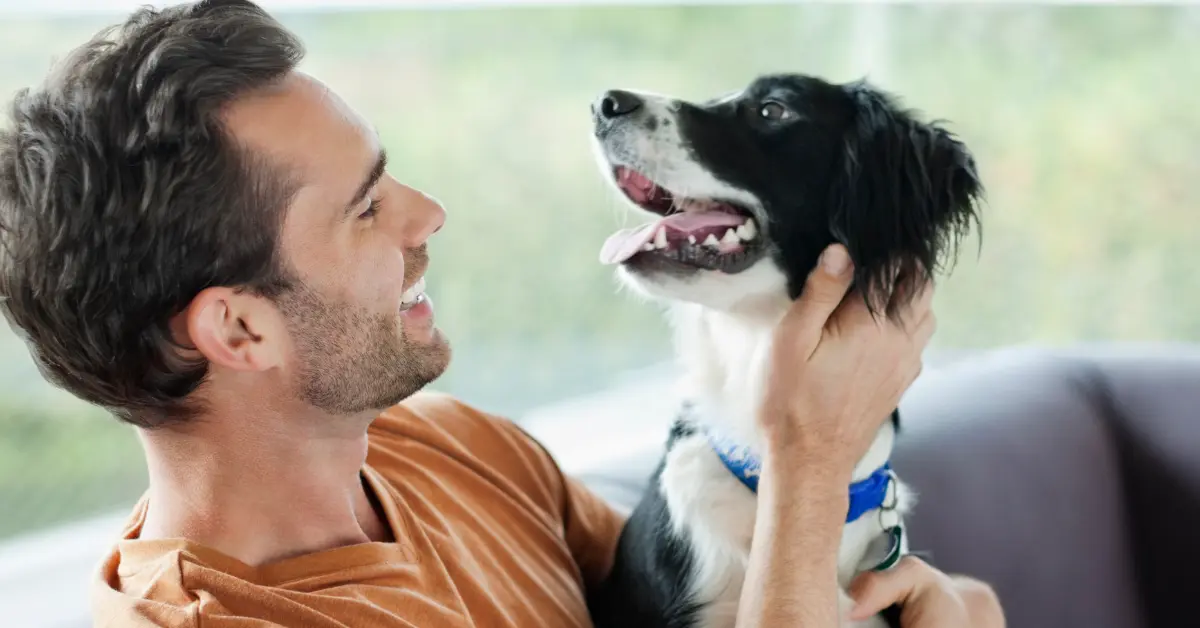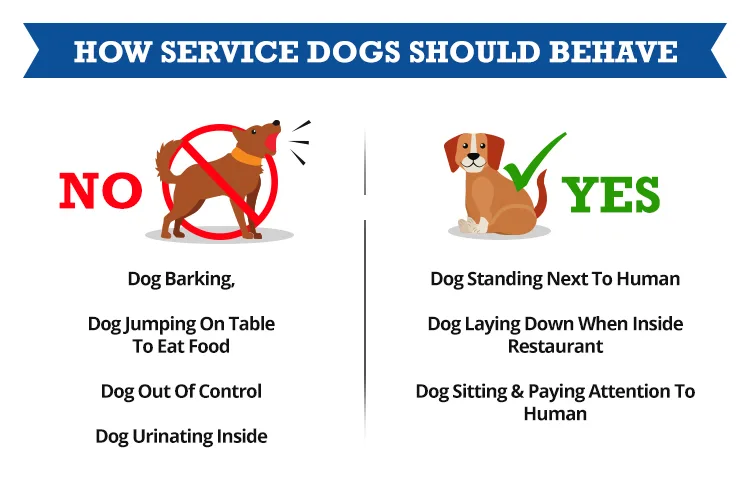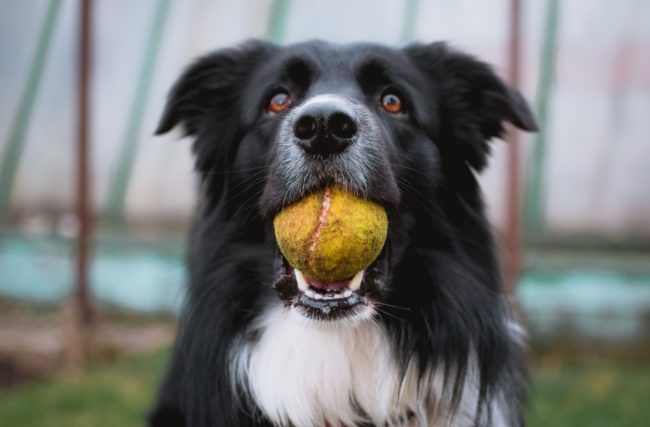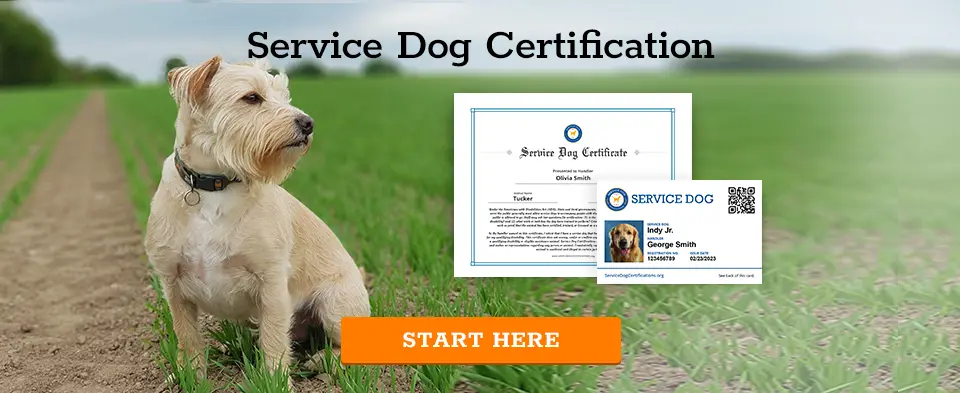How to Choose a Service Dog Prospect

Finding the right dog for service work isn’t like picking a pet because you need a dog with the right temperament, health, and background for performing service dog tasks.
We’re here to help you avoid common mistakes like falling in love with a cute face or picking based on a breed you’ve always wanted. This guide walks you through exactly where to look and what to test when you find a potential prospect.
Here are the steps to choosing a service dog prospect:
- Know what type of service work you need
- Find the right sources for prospects
- Screen prospects before meeting them
- Test temperament in person
- Check health and background
- Make your decision
Know What Type of Service Work You Need
Before you start looking, write down the specific tasks your service dog will do. This determines everything else about your search because the tasks your dog performs shape everything about what kind of dog you need. Size, energy level, even personality traits all flow from this basic question. Here are some examples of what to consider:
Mobility Work Requirements
Mobility work needs a larger, strong dog. Think 60+ pounds for most handlers. You need a dog that can brace against your weight without getting hurt.
German Shepherds, Labs, and Golden Retrievers often work well here. Their size helps, but their steady temperament matters just as much. A nervous 80-pound dog won’t give you confident support.
Your dog will also need to navigate tight spaces, such as grocery store aisles, airplane seats, and restaurant tables. A Great Dane might be strong enough, but they’re tricky to maneuver in small spaces. For more information, check out our guide on best mobility service dog breeds.
Psychiatric Service Work Needs
Psychiatric service dogs need to form a strong bond with their owners and remain calm under pressure. These dogs interrupt nightmares, provide deep pressure therapy, or create space in crowds.
Golden Retrievers and Standard Poodles often excel in this area because they read human emotions well and stay steady when their handler is struggling. Labs work too, though some can be a bit too enthusiastic for certain psychiatric tasks. Smaller dogs are also great emotional support companions, especially if you have a smaller living space.
The dog needs to be large enough for deep pressure work if that’s a required task. A 15-pound dog might not be able to provide sufficient pressure. Click on our guide on the best psychiatric service dog breeds for more details.
Medical Alert Work Demands
Medical alert dogs detect blood sugar changes, seizures, or other medical conditions and need strong scenting ability and the drive to keep alerting until you respond.
Border Collies and Belgian Malinois can be excellent choices, but only if you can effectively manage their high energy levels. These breeds need jobs to do or they’ll find their own entertainment. That might mean shredding your couch or developing obsessive behaviors.
Dogs with a hunting lineage are also great for this type of work because they possess the nose and the persistence for it.
Find the Right Sources for Prospects
Good breeders who health test and properly socialize can be great places to find a service dog prospect, but you need breeders who understand what service work actually requires.
Look for breeders who ask lots of questions about your plans. They should want to know about your living situation, dog experience, and specific service work needs. If they just want to make a sale, keep looking.
The best breeders often have waiting lists. They might not have a puppy available right now, but they can help you plan for their next litter.
Avoid breeders who can’t show health testing results, and be wary of breeders with multiple litters available at once. Good breeders plan carefully and often have waiting lists.
Don’t be afraid to look for a service dog prospect at a shelter or from a rescue organization. The best programs can tell you about a dog’s temperament, energy level, and how they respond to training. They might even have basic obedience already started.
Look for shelters that use foster programs where dogs live in homes, not just kennels. Foster families often know their dogs better than anyone else. They get to see how dogs really behave in daily routines, with visitors, and in everyday household situations. And they can tell you what the dog’s real energy level looks like throughout the day.
Dogs end up in foster care for all kinds of reasons. Maybe their owner was deployed or had to move. It doesn’t mean anything’s wrong with the dog.
Screen Prospects Before Meeting Them
You’ll save yourself weeks of driving around to meet inappropriate dogs if you get good at phone screening. Most dogs that won’t work for service can be ruled out with a simple conversation.
Start by explaining what you’re looking for. Don’t just say “service dog.” Explain the specific work you need the dog to do. This helps the person understand what you’re really asking about.
Then ask about the dog’s daily behavior in specific situations.
“How does the dog react when the doorbell rings?” A good prospect might bark once to alert, then settle down when they see you’re handling it. A dog that goes crazy for ten minutes and can’t be calmed down won’t be suitable.
“What happens when you drop something loud in the kitchen?” You want a dog that might startle but recovers quickly and maybe comes to investigate. A dog that hides for an hour after a loud noise will struggle with the unpredictability of public spaces.
“How does the dog act around strangers who come to the house?” Look for friendly but not overly excited responses. The dog should be interested in meeting new people without jumping all over them.
“Does the dog have any fears or things that make them nervous?” Everyone’s honest about big fears, but listen for more minor issues too. A dog that’s terrified of men in hats or shopping carts might not be obvious problems until you’re trying to move around a store.
“How does the dog respond when you call their name?” A dog that consistently responds to their name shows they’re already tuned into human communication. Dogs that ignore their names or only come when they feel like it can be harder to train.
“What motivates the dog? Food, toys, praise?” Dogs motivated by food or praise are generally easier to train than dogs who are only motivated by prey drive or play.
“How does the dog handle being told ‘no’ or corrected?” You want a dog that accepts correction and tries to figure out what you want instead. Dogs that shut down completely or ignore corrections entirely often struggle with training.
Red Flags for Service Dog Prospects
These are some red flags you’ll want to avoid when choosing a service dog prospect:
- Any history of aggression toward people, even if it was “just that one time” or “they were provoked.” Aggression rarely gets better with training, and service dogs can’t have any history of human aggression.
- Severe separation anxiety that involves destructive behavior or hours of barking. Service dogs need to be able to handle being left alone sometimes.
- Obsessive behaviors like tail chasing, excessive licking, or fence running. These behaviors usually get worse under stress, not better.
- Resource guarding around food, toys, or spaces. Service dogs need to be completely trustworthy around food and possessions.
Follow-Up Questions
If the initial screening goes well, dig deeper into the dog’s background.
“Tell me about the dog’s socialization as a puppy. What were they exposed to?” Proper puppy socialization creates confident adult dogs. Dogs that weren’t socialized often develop fear issues that can’t be completely fixed.
“Has the dog ever bitten anyone or shown aggressive behavior?” Don’t just ask about bites. Also, ask about growling, snapping, or aggressive posturing.
“What’s the dog’s energy level like? How much exercise do they need?” Make sure you can meet the dog’s exercise needs. An under-exercised dog won’t be able to focus on training or service work.
“Are there any ongoing health issues or medications?” Some health issues don’t disqualify a dog, but you need to know about them upfront.
Make sure to keep notes during these calls. After talking to several places, the details will start to blur together.

Test Temperament in Person
Phone screening helps you find the right dog, but you can’t judge their temperament over the phone. These in-person tests reveal whether a dog has the foundational traits needed for service work.
The First Impression Test
When you first arrive, observe the dog before they know you’re there. Look through a window or have the owner bring the dog outside while you watch from your car.
How does the dog move around their space? Confident dogs explore and investigate. They might check out your car or look around for the source of new sounds.
Fearful dogs often freeze, hide behind their owner, or slink around with their tail down. These dogs might warm up eventually, but they’re starting from a deficit that’s hard to overcome.
Overly excited dogs bounce off the walls, bark frantically, or can’t settle down. This level of arousal makes learning difficult and can be overwhelming in public spaces.
The Ignore Test
When you first meet the dog, ignore them completely for a few minutes. Don’t make eye contact, don’t talk to them, don’t try to pet them.
A good service dog prospect will be curious about you but not demanding. They might approach and sniff, then back off to observe. They should show interest without being pushy.
Dogs that completely ignore you might be too independent for service work. Dogs that can’t leave you alone might be too needy or anxious.
Watch how long it takes them to settle. Good prospects might be excited initially, but should calm down within a few minutes of your arrival.
Basic Response Tests
Try calling the dog’s name from across the room. They should at least look at you, even if they don’t come over. Dogs that completely ignore their names often ignore their handlers, too.
Clap your hands or make a kissing sound. See if the dog shows interest in you. You’re looking for a dog that’s naturally drawn to human interaction.
Sit on the floor and see if the dog approaches you. Good prospects are usually curious about people and want to investigate new humans.
The Noise Recovery Test
Drop your keys behind the dog when they’re not expecting it. This tests both sound sensitivity and recovery time.
Most dogs will startle. That’s normal and expected. What matters is how quickly they recover and what they do next.
Good prospects might jump or look around, then approach to investigate what made the noise. They should be back to normal behavior within seconds.
Dogs that freeze for long periods, try to hide, or can’t be calmed down for several minutes will struggle with the unpredictable noises in public spaces.
Try this test a couple of times with different objects. Drop a book, bang a pot lid, or rustle a plastic bag. The dog should start to expect noises and recover even faster.
The Stranger Test
Have someone the dog doesn’t know approach slowly and calmly. This person should ignore the dog initially, then offer a treat or gentle attention.
Good prospects are interested in meeting new people. They might be cautious initially, but should warm up within a few minutes.
Dogs that hide, growl, or show fear aggression toward strangers will never be suitable for public access work, because service dogs need to be completely comfortable with human strangers.
Dogs that go crazy with excitement aren’t necessarily disqualified, but they’ll need significant work on impulse control and calm greetings.
The Handling Test
Service dogs need to accept handling for grooming, vet care, and public access situations. Gently touch the dog’s paws, ears, mouth, and tail to see how they respond.
Start slowly and watch the dog’s body language. They might be initially hesitant, but should relax as you continue.
Dogs that snap, growl, or become aggressive during handling can’t safely do service work. Dogs that are just wiggly or try to play can usually be trained to accept handling.
The Food and Toy Test
Offer the dog a treat and watch how they take it. Good prospects have soft mouths and take treats gently, even when they’re excited.
Dogs that snatch, grab, or bite when taking treats can accidentally hurt someone. This behavior can sometimes be trained out, but it’s much easier to start with a dog that already has good manners.
If the dog has a favorite toy, ask to see how they play with it. Dogs that become possessive or overly intense with toys might have issues sharing space or resources. Try taking the toy away gently and giving it back. The dog should let you take it without a fuss.

Check Health and Background
Health problems are a common reason service dogs are dropped from training. A dog that develops hip dysplasia or vision problems can’t safely work, no matter how perfect their temperament.
Background issues are almost as important. For example, dogs with poor socialization or traumatic experiences often develop fears that can’t be completely overcome.
Health Records You Need to See
Ask for complete veterinary records, not just a vaccination card from the pet store. Real vet records show the dog’s medical history and any ongoing issues.
Look for regular checkups with the same veterinary clinic. This shows the dog has received consistent care and the vet knows their history.
Check vaccination dates to make sure they are current and follow proper spacing. Puppies need a series of shots, and adult dogs need annual boosters.
Note any medications the dog is currently taking. Some medicines are fine for service dogs, but others might indicate health problems that could interfere with their work.
Look for any mention of behavioral issues in the vet notes. Sometimes vets note things like “aggressive during exam” or “fearful, needed muzzle” that owners don’t mention.
Health Clearances for Breeding Age Dogs
For dogs over 18 months old, you need to see official health clearances, not just a vet saying “his hips look good.” Hip and elbow clearances check for dysplasia that can cause pain and mobility problems later. These conditions often don’t show symptoms until the dog is working hard regularly.
Eye clearances screen for genetic conditions that can cause blindness. Conditions like progressive retinal atrophy and other eye diseases can end a service dog’s career early.
Heart clearances check for genetic heart conditions that might not show symptoms for years. A dog that develops heart problems can’t handle the physical demands of service work.
Some breeds need additional testing. German Shepherds should be tested for degenerative myelopathy. Standard Poodles need sebaceous adenitis testing. Research and familiarize yourself with your breed’s common health issues.
Screening for health is extra important for service dogs because pet dogs can live happy lives with mild hip dysplasia or other manageable conditions, but service dogs can’t. The physical and mental demands of service work require dogs to be in excellent physical and mental health.
A service dog that develops health problems during training represents thousands of dollars and months or years of lost time and effort. You can’t just switch to a different dog and start over quickly.
Health problems also affect the dog’s working lifespan. A healthy dog might work for 8-10 years. A dog with health issues might only work for 3-5 years before retiring.
Make Your Decision
This is where many people get stuck. They overthink the decision or keep looking for the perfect dog that doesn’t exist. Don’t rush this decision, but don’t drag it out forever either. If you’ve done your homework and found a dog that meets your basic requirements, spending weeks agonizing over minor details won’t help because good prospects don’t stay available forever. While you’re debating, someone else might adopt the dog you’re considering.
That said, don’t let anyone pressure you into a quick decision. Phrases like “we have other people interested” or “this deal won’t last” are red flags. Good sources want you to be sure.
All the tests and evaluations in the world can’t replace your instincts about whether a dog is right for you. If something feels wrong, even if you can’t explain why, listen to that feeling.
On the flip side, if a dog feels right and passes your basic requirements, don’t talk yourself out of it by looking for problems that aren’t there.
You’ll be working closely with this dog for years. Choose someone you genuinely enjoy spending time with and understand that the perfect service dog prospect doesn’t exist. Every dog has something that could be better. The key is finding a dog whose strengths match your needs and whose weaknesses are things you can work with.
A slightly shy dog might not be ideal, but if they’re curious and willing to try new things, they can often build confidence with proper training.
A high-energy dog might be challenging, but if you can meet their exercise needs, that energy can translate into great work ethic.
A dog that’s not food motivated might be harder to train, but dogs motivated by praise or play can be just as successful.
Write down your non-negotiables before you start looking. Things like “no aggression history” or “must be at least 50 pounds” shouldn’t change based on falling in love with a particular dog.
Everything else is negotiable based on the specific dog and your situation. And above all, don’t be discouraged! The right service dog for you is out there. Just stay focused on your actual needs rather than getting distracted by cute faces or emotional appeals. Do your diligence and trust yourself to recognize the right dog when you find them, and you’ll meet your service dog before you know it.
About the Author: The writing team at Service Dog Certifications is made up of folks who really know their stuff when it comes to disability laws and assistance animals. Many of our writers and editors have service dogs themselves and share insights from their own experiences. All of us have a passion for disability rights and animals.
Related Articles

Do Border Collies Make Good Service Dogs?
When choosing a service dog, whether it be for physical or psychiatric disability, it has to be “need over breed.” Let’s face it, you may love the Chihuahua breed, but when it comes to aiding you with specific tasks, this little guy may not be up for the job. Do Border Collies make good service […]

Read More

Can a Yorkie Be a Service Dog?
The Yorkshire Terrier is a big dog in a small package. With his silky coat and traditional “topknot,” the Yorkie is sure to attract attention wherever he goes. And because of his pint-size, this dog often travels in style – in designer doggy purses or special totes made just for those “elite” pooches. The Yorkie […]

Read More

Can a Maltese Be a Service Dog?
Who can resist the snow white coat, dancing eyes, and spunky nature of the Maltese? This cute, spritely little pooch excels at many things like agility, tracking, obedience, and rally. Can a Maltese be a Service Dog? If so, you would be able to go anywhere you go with your Maltese! Read on as we […]

Read More
